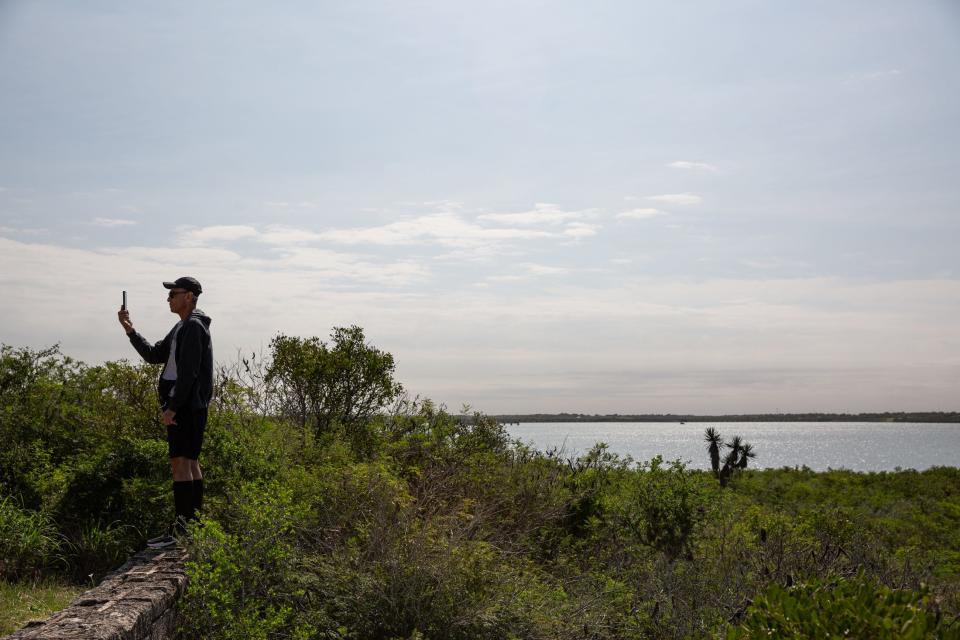Here are the rules for Stage 2 drought restrictions – and why they are in effect.
Going on two years since the city first instituted Stage 1 drought restrictions, tighter rules for how —-and how often – water may be used are officially here.
In a news conference Tuesday morning, City Manager Peter Zanoni declared Stage 2 drought – a condition that goes into effect when the combined capacity of Lake Corpus Christi and the Choke Canyon Reservoir fall below 30%.
As of Monday, the combined capacity was measured at about 29.4%, Zanoni said.
The most notable restriction change is how often sprinklers and automated irrigation systems may be used.
The city has been under Stage 1 drought restrictions since June 2022 – and since then, residents have been permitted to use automated irrigation systems or sprinklers only one day per week.
Starting Tuesday, large-volume users, commercial, multifamily and residential housing properties will only be allowed to use automated irrigation systems or sprinklers for outdoor watering one day every two weeks.

Forecasts by National Weather Service meteorologists do not indicate precipitation in the near-, short- or long-term future, Zanoni said.
“We may be in Stage 2 for some time to come,” he said. “The reason we’re in Stage 2 is to conserve water – everybody has to be mindful of this. We have to work together as a community.”
What is allowed under Stage 2 drought restrictions?
Allowed anytime: Watering by hand with a bucket of five gallons filled by a faucet, a hose with a positive shut-off nozzle or a drip-irrigation system, which also requires a positive shut-off device, according to a news release.
Allowed one day every two weeks: Outdoor watering with sprinklers or an automated irrigation system, except for the hours between 10 a.m. and 6 p.m., and only on your trash pickup day. An exception to the rule is Calallen. Calallen’s designated watering days coincide with the last digit of the property’s address, according to city officials.
Any other days or times outside those designated windows is considered a violation.
What happens if I don't follow the rules?
The rules apply to everyone – residential, multifamily, commercial and industrial properties, city officials said.
“We all use the same water,” Zanoni said. “This measure of going into Stage 2 has to be accepted by everybody so that we conserve water to get through what could be a very dry spell.”
Staff plan to give violators of drought restrictions two warnings. Violations following repeated warnings could lead to a citation – a Class C misdemeanor, with fines as high as $500.
It’s a change from when citations were first implemented, when warnings were largely not given.
“We know that people can forget about when is my watering day, they can forget we’re in Stage 2, they could leave town, anything could happen,” Zanoni said. “So we will continue to educate the community on the requirements of Stage 2.”
Enforcement applies also to nights and weekends, according to city officials.
Instituted in late July 2022, personnel in the first nine months issued about 1,600 citations assessed in three categories: watering on the wrong day, watering between 10 a.m. and 6 p.m. or watering into gutters.
During that upped enforcement period, watering on the wrong day made up the lion’s share of the citations, totaling about 80%.
City officials have a way to check designated watering days, either by calling 3-1-1 or visiting www.cctexas.com.
What are the other stages of drought?
Under the city of Corpus Christi’s categorization, there are three stages of citywide drought directly related to the combined lake capacities. Here’s a brief breakdown on what those look like, according to the city’s Drought Contingency Plan and presentations.
Stage 1 drought: Combined lake capacities are below 40%, what city officials consider to be mild drought conditions. Stage 1 drought restrictions are not lifted until combined lake capacities are at least 50%.
Stage 2 drought: Combined lake capacities are below 30%. This is considered in Corpus Christi as a moderate drought. Stage 2 drought restrictions are not lifted until that combined capacities reach at least 40%.
Stage 3 drought: Combined lake level capacities are below 20%. City officials consider this range a critical water shortage. Restrictions are not lifted until the combined lake capacity reaches at least 30%.
What steps is the city taking?
City officials are working on several projects intended to increase water supply, including desalination, groundwater and improvements to the O.N. Stevens Plant and Mary Rhodes pipeline, Zanoni said.
Personnel are also prioritizing repairs and leaks within the water system, according to a news release.
Mayor Paulette Guajardo described measures taken by the community as “essential to conserve water and to mitigate the impact of continued drought conditions.”
“Today is a critical day, it really is – we stand at a crossroads here in Corpus Christi,” she said. “My hope is that we can unite in our commitment to water conservation, continued resilience and of course, building and continuing to diversify our water resources and our water supply.”
More: City officials are concerned about water usage by a proposed ammonia plant. Here's why.
More: Here's how many tickets the city issued for drought restriction violations
This article originally appeared on Corpus Christi Caller Times: corpus christi stage 2 drought restrictions as water supply drops

